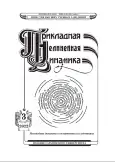Compartmental spiking neuron model CSNM
- Authors: Bakhshiev A.V.1, Demcheva A.A.1
-
Affiliations:
- Peter the Great St. Petersburg Polytechnic University
- Issue: Vol 30, No 3 (2022)
- Pages: 299-310
- Section: Articles
- URL: https://journals.rcsi.science/0869-6632/article/view/252082
- DOI: https://doi.org/10.18500/0869-6632-2022-30-3-299-310
- ID: 252082
Cite item
Full Text
Abstract
About the authors
Aleksandr Valeryevich Bakhshiev
Peter the Great St. Petersburg Polytechnic University
ORCID iD: 0000-0002-1284-0088
Polytechnicheskaya, 29
Alexandra Andreevna Demcheva
Peter the Great St. Petersburg Polytechnic UniversityPolytechnicheskaya, 29
References
- Shrestha A., Mahmood A. Review of deep learning algorithms and architectures // IEEE Access. 2019. Vol. 7. P. 53040-53065. doi: 10.1109/ACCESS.2019.2912200.
- James C. D., Aimone J. B., Miner N. E., Vineyard C. M., Rothganger F. H., Carlson K. D., Mulder S. A., Draelos T. J., Faust A., Marinella M. J., Naegle J. H., Plimpton S. J. A historical survey of algorithms and hardware architectures for neural-inspired and neuromorphic computing applications // Biologically Inspired Cognitive Architectures. 2017. Vol. 19. P. 49-64. doi: 10.1016/j.bica.2016.11.002.
- Tavanaei A., Ghodrati M., Kheradpisheh S. R., Masquelier T., Maida A. Deep learning in spiking neural networks // Neural Networks. 2019. Vol. 111. P. 47-63. doi: 10.1016/j.neunet.2018.12.002.
- Marcus G. Deep Learning: A Critical Appraisal [Electronic resource] // arXiv:1801.00631. arXiv Preprint, 2018. 27 p. Available from: https://arxiv.org/abs/1801.00631.
- Gerstner W. Population dynamics of spiking neurons: Fast transients, asynchronous states, and locking // Neural Computation. 2000. Vol. 12, no. 1. P. 43-89. doi: 10.1162/089976600300015899.
- Gerstner W., Kistler W. M. Spiking Neuron Models: Single Neurons, Populations, Plasticity. Cambridge: Cambridge University Press, 2002. 480 p. doi: 10.1017/CBO9780511815706.
- Izhikevich E. M. Simple model of spiking neurons // IEEE Transactions on Neural Networks. 2003. Vol. 14, no. 6. P. 1569-1572. doi: 10.1109/TNN.2003.820440.
- Hodgkin A. L., Huxley A. F. A quantitative description of membrane current and its application to conduction and excitation in nerve // Bulletin of Mathematical Biology. 1990. Vol. 52, no. 1-2. P. 25-71. doi: 10.1007/BF02459568.
- Bell J. Cable theory // In: Binder M. D., Hirokawa N., Windhorst U. (eds) Encyclopedia of Neuroscience. Berlin, Heidelberg: Springer, 2009. doi: 10.1007/978-3-540-29678-2_775.
- Lindsay A. E., Lindsay K. A., Rosenberg J. R. Increased computational accuracy in multi-compartmental cable models by a novel approach for precise point process localization // Journal of Computational Neuroscience. 2005. Vol. 19, no. 1. P. 21-38. doi: 10.1007/s10827-005-0192-7.
- Бахшиев А. В., Романов С. П. Воспроизведение реакций естественных нейронов как результат моделирования структурно-функциональных свойств мембраны и организации синаптического аппарата // Нейрокомпьютеры: разработка, применение. 2012. № 7. С. 25-35.
- Bakhshiev A., Gundelakh F. Mathematical model of the impulses transformation processes in natural neurons for biologically inspired control systems development // In: Supplementary Proceedings of the 4th International Conference on Analysis of Images, Social Networks and Texts (AIST-SUP 2015). Vol. 1452. Yekaterinburg, Russia, April 9-11, 2015. Aachen, Germany: CEUR-WS, 2015. P. 1-12.
- Бахшиев А. В. Перспективы применения моделей биологических нейронных структур в системах управления движением // Информационно-измерительные и управляющие системы. 2011. № 9. С. 85-90.
- Экклс Дж. Физиология синапсов. М.: Мир, 1966. 396 с.
- Neuro Matlab: модели спайковых нейронов в Matlab Simulink [Электронный ресурс]. Режим доступа: https://github.com/aicommunity/NeuroMatlab.
- Бахшиев А. В., Корсаков А. М., Астапова Л. А., Станкевич Л. А. Структурная адаптация сегментной спайковой модели нейрона // Труды VII Всероссийской конференции «Нелинейная динамика в когнитивных исследованиях - 2021». Нижний Новгород, 20-24 сентября 2021. Нижний Новгород: Институт прикладной физики РАН, 2021. С. 30-33.
Supplementary files










